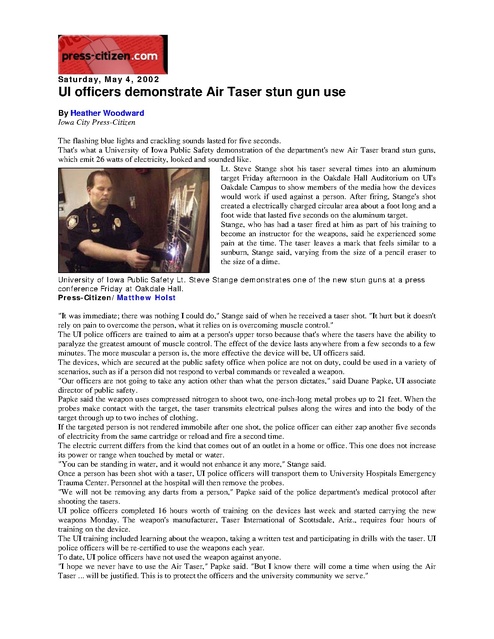Taser Ui Officers Demo 2002
Download original document:

Document text

Document text
This text is machine-read, and may contain errors. Check the original document to verify accuracy.
---~com Saturday, May 4, 2002 02 UI officers demonstrate Air Taser stun gun use By Heather Woodward Iowa City Press-Citizen The flashing blue lights and crackling sounds lasted for five seconds. That's what a University of Iowa Public Safety demonstration of the department's new Air Taser brand stun guns, which emit 26 watts of electricity, looked and sounded like. Lt. Steve Stange shot his taser several times into an aluminum target Friday afternoon in the Oakdale Hall Auditorium on UI's Oakdale Campus to show members of the media how the devices would work if used against a person. After firing, Stange's shot created a electrically charged circular area about a foot long and a foot wide that lasted five seconds on the aluminum target. Stange, who has had a taser fired at him as part of his training to become an instructor for the weapons, said he experienced some pain at the time. The taser leaves a mark that feels similar to a sunburn, Stange said, varying from the size of a pencil eraser to the size of a dime. University of Iowa Public Safety Lt. Steve Stange demonstrates one of the new stun guns at a press conference Friday at Oakdale Hall. Press-Citizen/Matthew Holst "It was immediate; there was nothing I could do," Stange said of when he received a taser shot. "It hurt but it doesn't rely on pain to overcome the person, what it relies on is overcoming muscle control." The UI police officers are trained to aim at a person's upper torso because that's where the tasers have the ability to paralyze the greatest amount of muscle control. The effect of the device lasts anywhere from a few seconds to a few minutes. The more muscular a person is, the more effective the device will be, UI officers said. The devices, which are secured at the public safety office when police are not on duty, could be used in a variety of scenarios, such as if a person did not respond to verbal commands or revealed a weapon. "Our officers are not going to take any action other than what the person dictates," said Duane Papke, UI associate director of public safety. Papke said the weapon uses compressed nitrogen to shoot two, one-inch-long metal probes up to 21 feet. When the probes make contact with the target, the taser transmits electrical pulses along the wires and into the body of the target through up to two inches of clothing. If the targeted person is not rendered immobile after one shot, the police officer can either zap another five seconds of electricity from the same cartridge or reload and fire a second time. The electric current differs from the kind that comes out of an outlet in a home or office. This one does not increase its power or range when touched by metal or water. "You can be standing in water, and it would not enhance it any more," Stange said. Once a person has been shot with a taser, UI police officers will transport them to University Hospitals Emergency Trauma Center. Personnel at the hospital will then remove the probes. "We will not be removing any darts from a person," Papke said of the police department's medical protocol after shooting the tasers. UI police officers completed 16 hours worth of training on the devices last week and started carrying the new weapons Monday. The weapon's manufacturer, Taser International of Scottsdale, Ariz., requires four hours of training on the device. The UI training included learning about the weapon, taking a written test and participating in drills with the taser. UI police officers will be re-certified to use the weapons each year. To date, UI police officers have not used the weapon against anyone. "I hope we never have to use the Air Taser," Papke said. "But I know there will come a time when using the Air Taser ... will be justified. This is to protect the officers and the university community we serve." Papke said that it cost about $23,875 to equip the department's 30 police officers with tasers. That price tag includes chargers, batteries, cartridges and holsters. The UI Parents Association picked up more than half the bill for the tasers, earmarking $12,000 for the department earlier this year. The rest was covered by the department's general fund. In January, the Iowa state Board of Regents approved tasers for officers at UI, Iowa State University and the University of Northern Iowa. The regents have asked for an annual report on the devices. Stange said an incident report would be filed each time a taser is fired and that the weapon contains a computer chip that records each shot.

